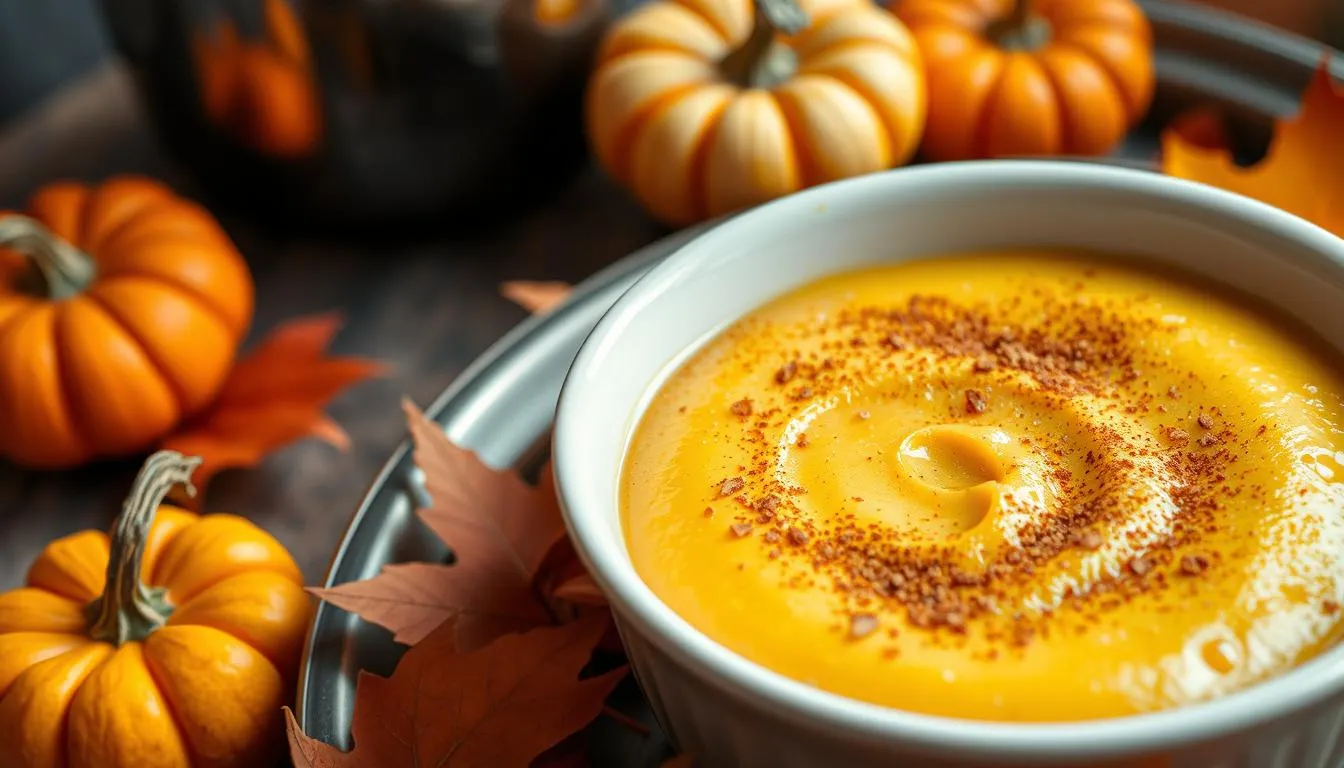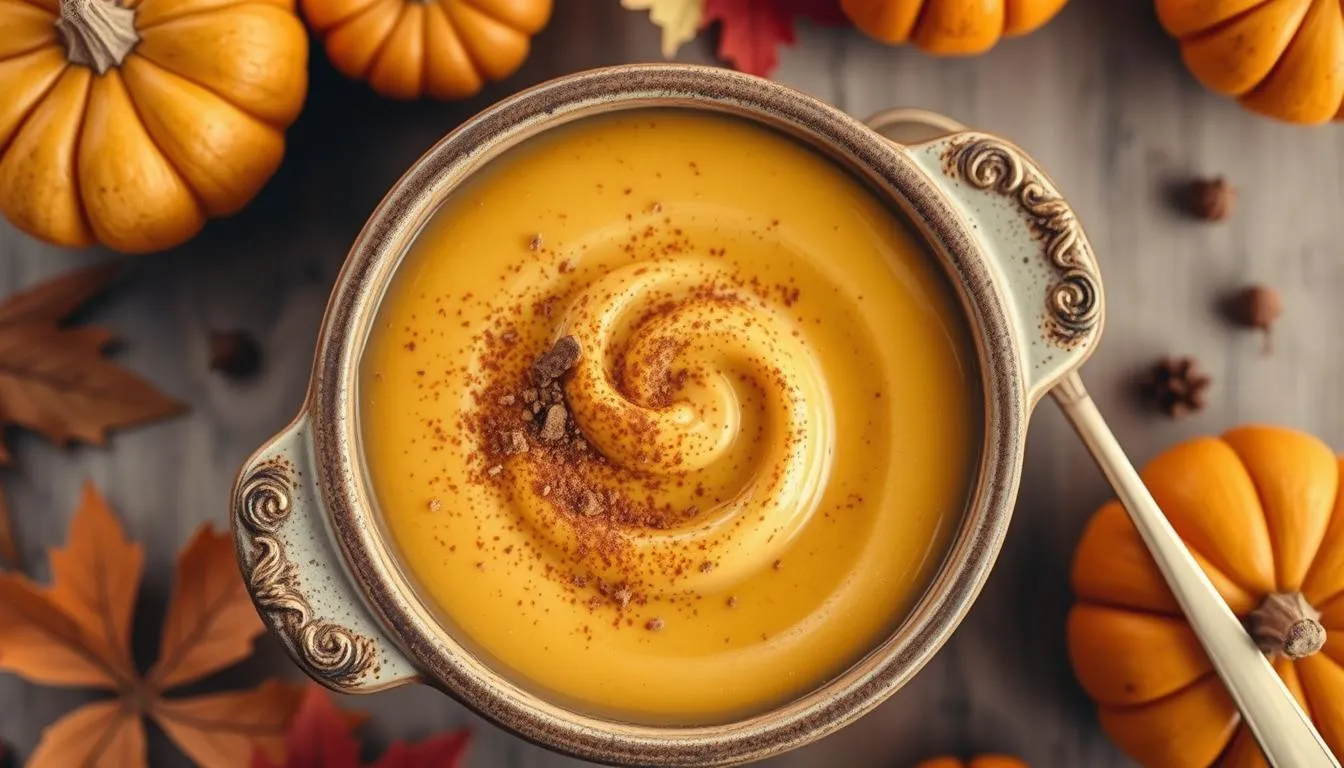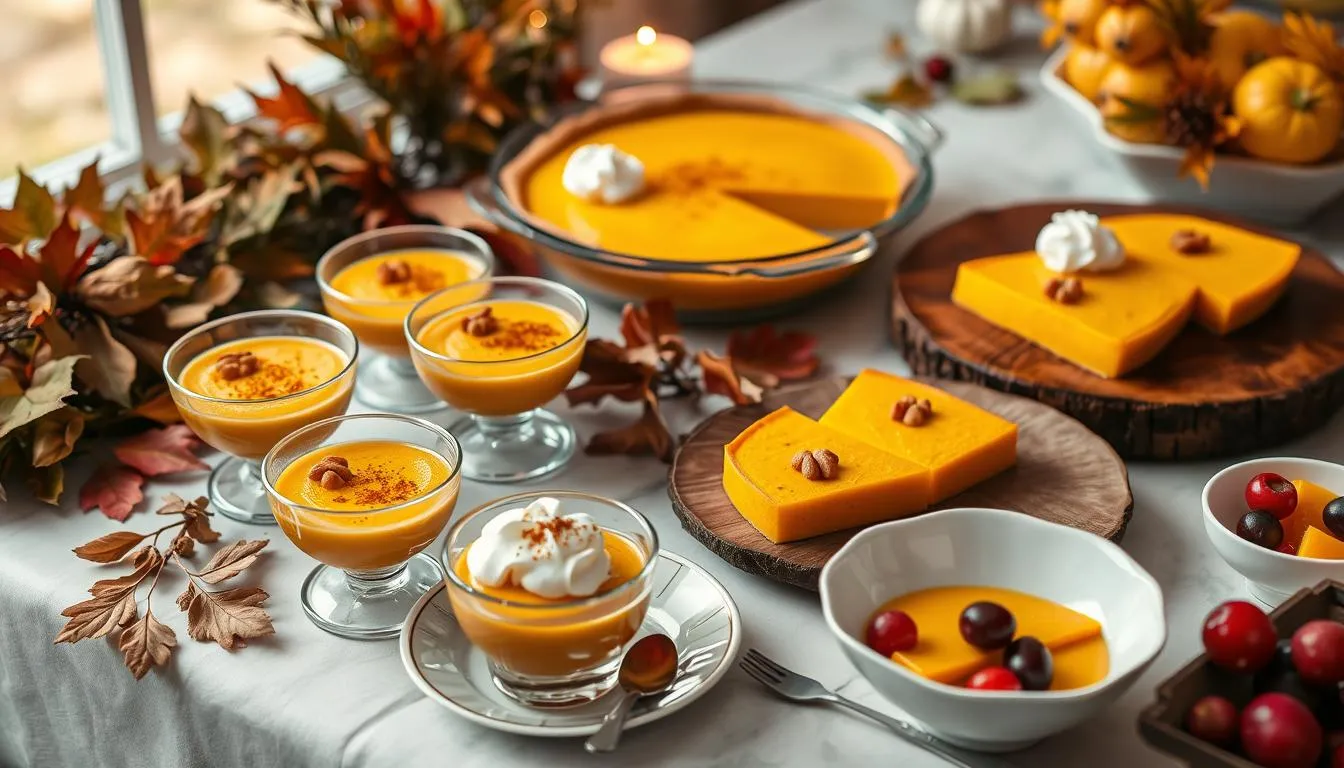Homemade pumpkin custard is a treat you can’t resist, perfect for fall. Its smooth texture and pumpkin spice make it a favorite. Making your own is fun and rewarding, whether you’re experienced or new to baking.
This guide will teach you to make the perfect homemade pumpkin custard. You’ll learn about the essential ingredients and cooking techniques. With practice and patience, you’ll enjoy a delicious pumpkin custard recipe soon.
Introduction to Pumpkin Custard
Pumpkin custard is special because of its rich, creamy texture and pumpkin spice. It’s perfect for any time of year. Enjoy it at a holiday dinner or as a sweet treat, and it’s sure to impress.
Key Takeaways
- You can make a delicious homemade pumpkin custard with just a few simple ingredients
- The key to a smooth, creamy texture is to cook the custard slowly and carefully
- Pumpkin spice is a key ingredient in any pumpkin custard recipe
- Homemade pumpkin custard is a great dessert for any time of year
- With a little practice and patience, you can create a perfect pumpkin custard recipe
- Homemade pumpkin custard is a fun and rewarding dessert to make
The Rich History of Pumpkin Custard
Pumpkin custard has a rich history, starting in Colonial America. It has grown to be a key part of fall desserts and seasonal baking. The mix of pumpkin, sweetened condensed milk, and spices created a unique taste that many loved.
The recipe for pumpkin custard spread across the colonies, becoming a favorite for special events. Pumpkin was easy to find and affordable, making it a dessert for everyone. Over the years, the recipe has changed, adding new ingredients and cooking methods to make the cream desserts we enjoy today.
- Early colonial recipes used pumpkin puree, sweetened condensed milk, and spices to create a simple yet delicious dessert.
- As trade and commerce expanded, new ingredients like cinnamon, nutmeg, and ginger were introduced, adding depth and complexity to the recipe.
- In modern times, creative variations of pumpkin custard have emerged, incorporating ingredients like maple syrup, cream cheese, and pecans to create unique and delicious fall desserts.
Today, pumpkin custard is a favorite dessert, enjoyed at family gatherings and holidays. Its long history and cultural importance have made it a key part of American cooking. It’s a must-have dessert in the fall season.
| Dessert | Ingredients | Season |
|---|---|---|
| Pumpkin Custard | Pumpkin puree, sweetened condensed milk, spices | Fall |
| Pecan Pie | Pecans, maple syrup, cream | Fall |
| Apple Crisp | Apples, oatmeal, cinnamon | Fall |
Essential Ingredients for Perfect Pumpkin Custard
To make the perfect pumpkin custard, choosing the right ingredients is key. For pumpkin recipes, the pumpkin type matters a lot. Use sugar pumpkins or pie pumpkins for their sweetness and smooth texture.
You’ll also need spices like cinnamon, nutmeg, and ginger. These add warmth and depth to your custard desserts. Heavy cream, sugar, and eggs are essential for a creamy texture.
Here are some key ingredients to keep in mind:
- Pumpkin puree
- Heavy cream
- Sugar
- Eggs
- Spices (cinnamon, nutmeg, ginger)
Using quality ingredients and a reliable recipe will make your pumpkin recipes stand out. Whether it’s for a special event or a cozy night in, the right ingredients are vital.
Kitchen Tools You’ll Need
To make the perfect pumpkin custard, you’ll need the right kitchen tools. Having the essential equipment and optional accessories can make a big difference. It’s all about being prepared and having the right tools at your disposal.
As you start gathering your kitchen tools, think about the dessert ideas you want to create. Pumpkin custard can be a versatile dessert. With the right tools, you can create a variety of presentations. From individual cups to large baking dishes, the options are endless.
Essential Equipment
- Mixing bowls
- Measuring cups and spoons
- Electric mixer
- Baking dishes
Optional Accessories
Optional accessories like a pastry brush, whisk, and spatula can make the baking process easier. These tools can help you achieve a smooth and creamy texture. This is essential for pumpkin custard.
Baking Vessel Options
The type of baking vessel you choose can affect the final product. Consider using a water bath to prevent cracking and ensure a smooth texture. With the right kitchen tools and baking tips, you’ll be well on your way to creating delicious pumpkin custard and exploring new dessert ideas.
Making the Perfect Pumpkin Custard Base
To make a tasty homemade pumpkin custard, start with a smooth base. Cook the pumpkin, mix the ingredients, and get the right consistency. Fresh pumpkin adds a vibrant flavor to your desserts.
Roast the pumpkin in the oven until it’s soft. Then, blend it with sweetened condensed milk, eggs, and spices. Stir the mix over low heat until it thickens and coats a spoon.
Here are some tips for the perfect consistency:
- Combine heavy cream and whole milk for a rich base
- Add a pinch of salt to balance sweetness and enhance flavors
- Use a water bath to cook the custard base and prevent curdling
By following these tips and using quality ingredients, you’ll get a creamy pumpkin custard base.
Always choose fresh, high-quality ingredients for the best taste and texture. With practice and patience, you’ll impress everyone with your pumpkin custard.
| Ingredient | Quantity |
|---|---|
| Pumpkin puree | 1 cup |
| Sweetened condensed milk | 1 cup |
| Heavy cream | 1/2 cup |
| Eggs | 2 |
| Spices | 1 tsp |
Mastering the Cooking Temperature and Time
Seasonal baking, like with pumpkin recipes, needs the right cooking temperature and time. You want your pumpkin custard to be smooth and taste great. Getting it just right is key.
To bake your custard perfectly, know the best oven settings. The ideal temperature is between 350°F and 375°F. This depends on your oven and the dish size. Also, the cooking time changes based on the custard size and oven temperature.
Optimal Oven Settings
Here are some tips for the best oven settings:
- Preheat to 350°F for a big custard, or 375°F for a small one.
- Use a water bath to stop the edges from cooking too fast.
- Rotate the dish halfway to cook evenly.
Visual Doneness Cues
To see if your custard is ready, look for these signs:
- The edges should be set, and the center a bit jiggly.
- The custard should be lightly puffed and golden brown at the edges.
Cooling Process
After baking, let your custard cool slowly to avoid cracking. Here’s how:
- Let it cool in the water bath for 10-15 minutes.
- Then, remove it and cool to room temperature on a wire rack.
By following these tips, you’ll master the cooking temperature and time for your pumpkin custard. Enjoy a delicious, smooth dessert perfect for seasonal baking.
| Temperature | Cooking Time | Visual Cues |
|---|---|---|
| 350°F | 35-40 minutes | Edges set, center slightly jiggly |
| 375°F | 25-30 minutes | Lightly puffed, golden brown edges |
Common Mistakes to Avoid
When making pumpkin custard, it’s key to know common mistakes. These can mess up the texture and taste. Here are some baking tips to help you avoid these issues and make a tasty dessert. Some common mistakes include:
- Overmixing the batter, which can make the custard dense or tough
- Incorrect oven temperatures, which can change the custard’s texture and consistency
- Inadequate cooling, which can cause the custard to crack or separate
To steer clear of these mistakes, stick to a reliable recipe. Also, keep an eye on the cooking temperature and time. With these dessert ideas and baking tips
Flavor Variations and Add-ins
Exploring pumpkin custard opens up a world of flavors. You can mix in seasonal spices or add creative toppings. Pumpkin custard is a classic in cream desserts, and a few tweaks can make it special.
Start by adding warm spices like cinnamon, nutmeg, or ginger. These spices enhance the pumpkin’s sweetness and add warmth. You can also add vanilla extract or chopped nuts for a unique twist.
Seasonal Spice Combinations
- Cinnamon and nutmeg for a classic fall flavor
- Ginger and cloves for a warm and spicy twist
- Cardamom and star anise for a unique and aromatic flavor
For toppings, the choices are endless. Try whipped cream, cinnamon, or chopped nuts. For something richer, add caramel sauce or sea salt to your pumpkin custard.
Creative Toppings
- Whipped cream and cinnamon for a classic combination
- Caramel sauce and chopped nuts for a decadent treat
- Sea salt and vanilla extract for a unique and flavorful twist
These variations and add-ins make pumpkin custard perfect for fall. It’s great for holiday parties or cozy nights at home. Pumpkin custard is sure to delight anyone.
| Flavor Variation | Description |
|---|---|
| Seasonal Spice Combinations | Warm spices like cinnamon, nutmeg, and ginger add a cozy touch to your fall desserts |
| Creative Toppings | Whipped cream, caramel sauce, and chopped nuts add a decadent touch to your cream desserts |
Serving and Storage Tips
Now that you’ve made your homemade pumpkin custard, it’s time to think about serving and storing it. You want it to look good and taste great, even after a few days. Here are some tips to help you.
When serving, get creative with your presentation. Try topping it with whipped cream, chopped nuts, or a sprinkle of cinnamon. This adds color and flavor. You can also serve it in individual cups or ramekins for a fancy look.
Presentation Ideas
- Top with whipped cream and a sprinkle of cinnamon
- Add a drizzle of caramel sauce
- Use fresh fruit, such as berries or sliced peaches
Storage Guidelines
To keep your pumpkin custard fresh, store it in an airtight container in the fridge for up to 3 days. You can also freeze it for up to 2 months. When you’re ready to serve, thaw it overnight in the fridge and reheat it in the microwave or oven.
Reheating Methods
To reheat your pumpkin custard, use the microwave or oven. For a quick reheating, microwave it for 10-15 seconds. For even heating, bake it in the oven at 350°F for 5-7 minutes. This way, you can enjoy your homemade pumpkin custard at its best, whether it’s fresh or reheated.
Health Benefits of Pumpkin Custard
Enjoying seasonal baking, like pumpkin recipes, has its perks. Pumpkin custard is not just tasty; it’s also good for you. It’s packed with vitamins and minerals, making it a healthy choice for your diet.
Here are some key health benefits of pumpkin custard:
- Vitamin A, which is essential for healthy vision and immune function
- Fiber, which can help promote digestive health and support healthy blood sugar levels
- Potassium, which is important for maintaining healthy blood pressure
Adding pumpkin recipes to your baking means you’re getting more nutrients in your desserts. Pumpkin custard is a great way to enjoy the flavors of the season while also supporting your overall health.
Pumpkin custard is also a delicious and versatile dessert. It’s perfect for holiday gatherings or cozy fall nights. It’s a treat that’s both tasty and good for you.
By baking with pumpkin, you can make desserts that are both delicious and healthy. So, go ahead and bake. Enjoy the tasty and healthy benefits of pumpkin custard!
Dietary Modifications and Substitutions
When making desserts, it’s key to think about dietary needs. You can make your pumpkin custard more inclusive with some tweaks. Try using non-dairy milk like almond or soy milk instead of regular milk.
For a dairy-free pumpkin custard, swap milk with these alternatives. You can also use honey or maple syrup to cut down on sugar. These changes make your dessert more inclusive and add a special touch to the classic recipe.
Dairy-Free Options
- Almond milk: a popular dairy-free alternative that works well in pumpkin custard
- Soy milk: another option that can be used as a substitute for traditional milk
- Coconut milk: a creamy alternative that can add a rich texture to your dessert
Sugar Alternatives
There are many sugar alternatives you can use, like honey, maple syrup, or agave nectar. These can give your pumpkin custard a unique taste while cutting down sugar. By using these tips, you can make a dessert that’s both tasty and welcoming for everyone.
Conclusion: Enjoying Your Homemade Pumpkin Custard Creation
Making homemade pumpkin custard is a fun journey. It’s filled with rich history, key ingredients, and special techniques. Now, you’re ready to enjoy the creamy delight you’ve made.
Share your pumpkin custard with family and friends. See the happiness it brings. You can stick to the classic recipe or try new spice blends. The warm, comforting tastes are sure to impress.
Don’t forget to post your creations online. It will inspire others to try making homemade pumpkin custard. Making this dessert from scratch is truly special. It’s a celebration of autumn’s flavors and the joy of homemade treats.
FAQ
What is pumpkin custard?
Pumpkin custard is a creamy dessert. It’s made with pumpkin puree, eggs, and cream or milk. It also includes sugar and spices. This treat is loved in the fall and holidays for its smooth texture and pumpkin flavors.
What are the key ingredients in pumpkin custard?
Pumpkin custard needs pumpkin puree, eggs, and cream or milk. It also includes sugar, cinnamon, nutmeg, and sometimes vanilla extract.
How do I achieve the perfect texture for pumpkin custard?
For the perfect texture, focus on cooking and cooling. Use gentle heat and avoid overbeating. Let it cool slowly to prevent cracking and ensure creaminess.
Can I make pumpkin custard with alternative ingredients?
Yes, you can make it dairy-free or low-sugar. Use non-dairy milk and sweeteners like honey or maple syrup instead.
What are some common mistakes to avoid when making pumpkin custard?
Avoid overbeating and using the wrong oven temperature. Also, don’t skip cooling it properly. These mistakes can cause cracking or a grainy texture.
How should I store and reheat pumpkin custard?
Store it in the fridge, covered, for 3-4 days. Reheat it gently on the stovetop or in the microwave. Be careful not to overcook it.
What are the health benefits of pumpkin custard?
Pumpkin is full of vitamins, minerals, and antioxidants. It has vitamin A, vitamin C, and fiber. While it’s a dessert, pumpkin adds nutritional value to your diet.



